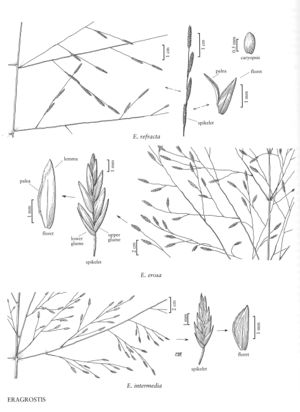Eragrostis intermedia
Plants perennial; cespitose, with innovations, without rhizomes, not glandular. Culms (30)40-90(110) cm, erect, glabrous below the nodes. Sheaths sparsely pilose on the margins, apices hairy, hairs to 8 mm, not papillose-based; ligules 0.2-0.4 mm; blades (4)10-20(30) cm long, 1-3 mm wide, flat or involute, abaxial surfaces glabrous, adaxial surfaces densely hairy behind the ligules, elsewhere usually glabrous, occasionally sparsely hairy. Panicles 15-40 cm long, (8.5)15-30 cm wide, ovate, open; primary branches 4-25 cm, diverging 20-90° from the rachises, capillary; pulvini hairy or glabrous; pedicels 2-14 mm, divergent. Spikelets 3-7 mm long, 1-1.8 mm wide, narrowly lanceolate, olivaceous to purplish, with (3)5-11 florets; disarticulation acropetal, paleas persistent. Glumes lanceolate to ovate, hyaline to membranous; lower glumes 1.1-1.7 mm, narrower than the upper glumes; upper glumes 1.3-2 mm, apices acuminate to acute; lemmas 1.6-2.2 mm, ovate, membranous, hyaline near the margins, lateral veins inconspicuous, apices acute; paleas 1.4-2.1 mm, hyaline, narrower than the lemmas, apices obtuse to acute; anthers 3, 0.5-0.8 mm, purplish. Caryopses 0.5-0.9 mm, rectangular-prismatic, somewhat laterally compressed, with a well-developed adaxial groove, striate, opaque, reddish-brown. 2n = ca. 54, 60, 72, ca. 74, 80, 100, 120.
Distribution
Maine, Va., Kans., Okla., Mass., Miss., Tex., La., Calif., Ala., Tenn., N.C., S.C., Ark., Ga., Ariz., N.Mex., Fla., Mo.
Discussion
Eragrostis intermedia grows in clay, sandy, and rocky soils, often in disturbed sites, at 0-1850 m. Its range extends from the United States through Mexico and Central America to South America. Eragrostis intermedia is similar to the more widespread E. lugens, but differs from that species in having wider spikelets, longer lemmas, and caryopses with a prominent adaxial groove.
Selected References
None.
